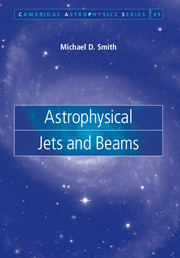Book contents
- Frontmatter
- Contents
- Preface
- 1 Introduction
- 2 Detection and measurement
- 3 The dynamical toolbox
- 4 Observations of extragalactic jets
- 5 Jets in galactic nuclei
- 6 Jets from young stars and protostars
- 7 Jets associated with evolved stars
- 8 Jets within the solar system
- 9 Jet launching
- 10 Jet propagation
- 11 The astrophysical jet
- References
- Index
5 - Jets in galactic nuclei
Published online by Cambridge University Press: 05 March 2012
- Frontmatter
- Contents
- Preface
- 1 Introduction
- 2 Detection and measurement
- 3 The dynamical toolbox
- 4 Observations of extragalactic jets
- 5 Jets in galactic nuclei
- 6 Jets from young stars and protostars
- 7 Jets associated with evolved stars
- 8 Jets within the solar system
- 9 Jet launching
- 10 Jet propagation
- 11 The astrophysical jet
- References
- Index
Summary
Single jets are seen to protrude from quasars as well as the cores of powerful radio galaxies. There is no physical principle which precludes intrinsically asymmetric systems, although a collapsed spinning object might be expected to possess a high degree of mirror symmetry. On the other hand, a system of merging binary black holes would certainly not. Nevertheless, the appearance of jets as one-sided led to the hypothesis that intrinsically symmetric twin jets contain radiating plasma that moves at relativistic speeds. The flux of one jet is Doppler-boosted for an observer lying within an emission cone centred on the jet direction, while the flux of the receding jet is reduced.
The discovery of knots of synchrotron emission seen to move in the sky away from quasar cores at speeds exceeding the speed of light turned into convincing evidence for the relativistic interpretation. The so-called superluminal motion was recorded in many quasar jets in the 1970s. The radio galaxy 3C 120 (z = 0.033) was observed at two epochs which suggested a speed of two to three times the speed of light (Shaffer et al., 1972). The quasar 3C 345 was observed at four epochs in 1974 and 1975. The apparent transverse speed was reported as eight times the speed of light (Cohen et al., 1976). As a result, an interpretation described in this chapter based on highly relativistic jet flows at a small angle to the line of sight became accepted.
- Type
- Chapter
- Information
- Astrophysical Jets and Beams , pp. 70 - 90Publisher: Cambridge University PressPrint publication year: 2012



